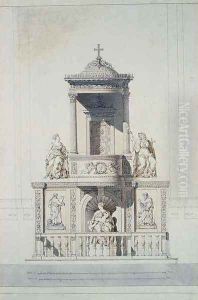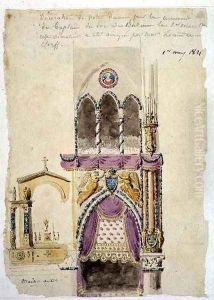Jacques Ignace Hittorff Paintings
Jacques Ignace Hittorff was a seminal French architect, born on August 20, 1792, in Cologne, which was then part of the Holy Roman Empire but is now in Germany. His career was marked by a profound influence on the architectural landscape of Paris during the 19th century, particularly in the development and implementation of the Neoclassical style, which sought to revive the principles and aesthetics of ancient Greek and Roman architecture. Hittorff moved to Paris in his early years to pursue his passion for architecture. He studied under the French architects Charles Percier and Pierre François Léonard Fontaine, who were prominent figures in the Empire style, an iteration of Neoclassicism that flourished under Napoleon I.
Throughout his career, Hittorff was deeply engaged in the academic and practical aspects of architecture. He became a member of the Académie des Beaux-Arts in 1838, which underscored his significant contributions to the field and his influence among his contemporaries. Hittorff's work on the Place de la Concorde, one of Paris's major public squares, is perhaps his most renowned project. He was responsible for the detailed design and construction of the square's layout and decorative elements, including the Luxor Obelisk and the surrounding fountains, which remain iconic features of Parisian urban landscape.
Hittorff was also known for his studies on ancient Greek architecture, which significantly influenced his architectural projects. He traveled extensively in Sicily and Greece, where he meticulously documented ancient buildings and their decorative elements. His findings were published in a series of influential works that contributed to the broader European understanding of Greek architecture and its application in contemporary design. This research informed much of his architectural output, including the design of the Cirque d'Hiver and the Gare du Nord train station in Paris, both of which integrate Neoclassical principles with a modern understanding of form and function.
Jacques Ignace Hittorff passed away on March 25, 1867, in Paris. His legacy is preserved not only in his monumental contributions to Paris's architectural heritage but also in his scholarly works, which continue to inform the study and appreciation of ancient architecture. Hittorff's career exemplifies the transition from the strict imitation of classical forms to a more interpretive, historically informed approach to Neoclassical design.

